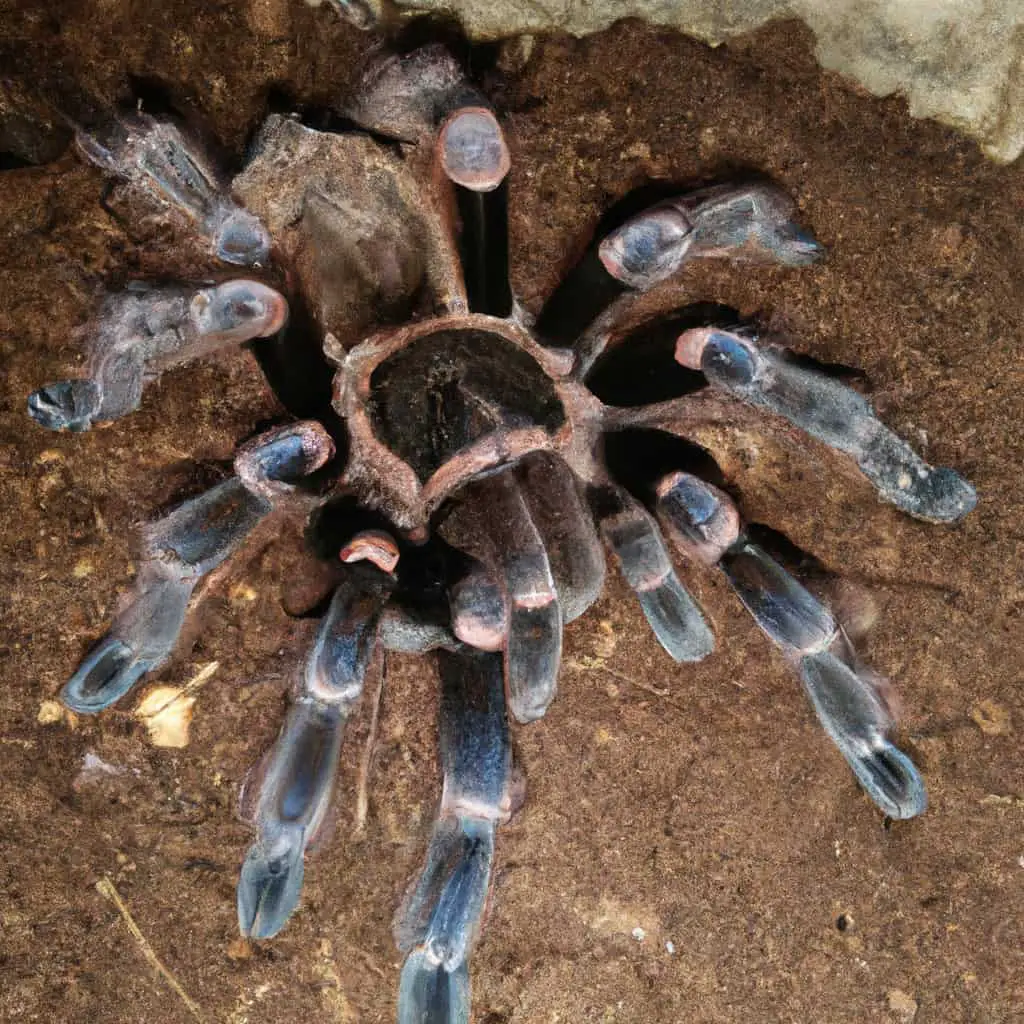As a tarantula owner, it can be heartbreaking to find your beloved pet has passed away. Understanding the common causes of tarantula death can help you identify potential issues and prevent future losses. While tarantulas can be hardy creatures, they are still susceptible to illness, dehydration, and stress, among other factors.
One important factor to consider is the lifespan of your tarantula species. Different species have varying lifespans, with some living only a few years and others living up to 20 years. Understanding the lifespan of your tarantula can help you anticipate potential health issues and provide appropriate care. In this article, we will explore the common causes of tarantula death and what you can do to prevent them.
Key Takeaways
- Understanding the lifespan of your tarantula species is important for anticipating potential health issues and providing appropriate care.
- Common causes of tarantula death include illness, dehydration, and stress.
- Regularly monitoring your tarantula’s health and providing proper care can help prevent future losses.

Understanding Tarantula Lifespan
As a tarantula owner, it’s important to understand the lifespan of your pet. Tarantulas have a relatively long lifespan compared to other arthropods, with the average lifespan ranging from 10 to 30 years. However, the lifespan of a tarantula can vary depending on its sex and species.
Female tarantulas generally live longer than males, with some species living up to 25 years or more. Males, on the other hand, have a shorter lifespan and usually only live for around 5 to 7 years after reaching maturity.
It’s important to note that tarantulas, like all living organisms, go through a natural life cycle. As they age, they become more susceptible to illness and injury, and their overall health may decline. This can lead to a shorter lifespan, especially if they are not properly cared for.
As a tarantula owner, it’s important to provide your pet with a suitable environment, including proper temperature, humidity, and substrate. You should also provide your tarantula with a varied and balanced diet, consisting of live insects and other prey.
In addition, it’s important to monitor your tarantula’s behavior and health regularly. Signs of illness or old age may include lethargy, loss of appetite, or difficulty moving. If you notice any concerning symptoms, it’s best to consult with a veterinarian who specializes in exotic pets.
By understanding the natural lifespan of your tarantula and providing proper care, you can help ensure that your pet lives a long and healthy life.
Common Causes of Tarantula Death
As a tarantula owner, it is important to understand the common causes of tarantula death in order to prevent them from happening. Here are some of the most common causes of tarantula death:
Dehydration
Tarantulas need access to clean water at all times. If they don’t have access to water, they can become dehydrated, which can lead to death. Make sure to provide a shallow water dish that is easy for your tarantula to access.
Stress
Tarantulas can become stressed or agitated if they feel threatened or are handled improperly. This can lead to a weakened immune system and an increased risk of illness or death. Avoid handling your tarantula unless absolutely necessary and make sure to provide a stress-free environment.
Injury
Injuries can occur if your tarantula falls or is dropped. This can lead to a condition known as the “death curl,” where the tarantula curls up into a ball and dies. Make sure to provide a safe and secure enclosure for your tarantula and avoid handling them in a way that could cause injury.
Illness
Parasites or bacterial infections are common causes of death in tarantulas. It’s important to keep the enclosure clean and free of any feces or uneaten food that could harbor bacteria. If you notice any signs of illness, such as lethargy or lack of appetite, seek veterinary care immediately.
Molting
Molting is a natural process that tarantulas go through in order to grow. However, if the conditions are not right, molting can be a dangerous process that can lead to death. Make sure to provide a humid environment and avoid handling your tarantula during the molting process.
By understanding the common causes of tarantula death, you can take steps to prevent them from happening and ensure that your tarantula lives a long and healthy life.
Molting Process and Its Risks
Molting is a crucial process in a tarantula’s life cycle. During this process, the tarantula sheds its old exoskeleton and grows a new one. The molting process can be a risky time for tarantulas, and it is essential to understand the process and its risks to ensure the safety of your pet.
One of the most significant risks during the molting process is the possibility of the tarantula getting stuck in its old exoskeleton. This can happen if the tarantula’s legs curl up during the molting process, preventing it from shedding its old skin completely. If this happens, the tarantula can suffocate or become deformed.
Another risk during the molting process is the possibility of the tarantula dying after molting. This can happen if the tarantula is weak or stressed before molting or if there are environmental factors that affect the molting process.
To help minimize the risks during the molting process, it is crucial to provide your tarantula with a suitable environment. This includes providing a large enough enclosure, maintaining proper humidity levels, and avoiding disturbing the tarantula during the molting process.
It is also essential to monitor your tarantula closely during the molting process. Look for signs that your tarantula is preparing to molt, such as a decrease in activity and a bald spot on its abdomen. Once your tarantula starts molting, avoid handling it and keep disturbances to a minimum.
In conclusion, the molting process is a critical time in a tarantula’s life, and it is essential to understand the process and its risks. By providing a suitable environment and closely monitoring your tarantula during the molting process, you can help ensure its safety and well-being.
Tarantula Dehydration
As a tarantula owner, you should know that dehydration is one of the most common causes of death in tarantulas. Tarantulas need water to survive, and a lack of water can quickly lead to dehydration, which can be fatal.
So, how do you know if your tarantula is dehydrated? One of the most obvious signs is a shrunken abdomen. If your tarantula’s abdomen looks smaller than usual, it could be a sign that it is dehydrated. Another sign is a curled leg, also known as the “death curl.” This happens when a tarantula is too weak to hold its legs straight and curls up in a defensive position.
To prevent dehydration, make sure your tarantula has access to fresh water at all times. You can provide a water dish in its enclosure, or mist the enclosure with water to create a moist environment. It’s important to note that tarantulas can drown in water dishes, so make sure the dish is shallow enough that your tarantula can climb out if it falls in.
If you suspect your tarantula is dehydrated, there are a few things you can do to help. First, provide fresh water and mist the enclosure to increase the humidity. You can also place a damp paper towel in the enclosure to provide additional moisture. If your tarantula is severely dehydrated, you may need to take it to a veterinarian for treatment.
In summary, dehydration is a common cause of death in tarantulas, but it is preventable. Make sure your tarantula has access to fresh water and a moist environment, and watch for signs of dehydration. If you suspect your tarantula is dehydrated, take action quickly to prevent further harm.
Enclosure Conditions and Their Effects
When it comes to keeping a tarantula, the enclosure is one of the most important factors in ensuring its health and wellbeing. A poorly maintained enclosure can lead to a variety of health problems, and ultimately, the death of your tarantula. In this section, I will discuss the different enclosure conditions that can affect your tarantula and their potential effects.
Substrate
The substrate is the material that lines the bottom of the enclosure. It is essential to choose a substrate that will not only provide a comfortable surface for your tarantula to walk on but also help maintain proper humidity levels. A substrate that is too dry or too damp can lead to health issues such as dehydration or respiratory infections.
Temperature
Tarantulas are cold-blooded, which means their body temperature is regulated by the environment around them. It is crucial to maintain a consistent temperature range in the enclosure to ensure your tarantula’s health. Extreme temperatures can cause stress and even death.
Environment
The environment in which your tarantula lives should mimic its natural habitat as closely as possible. This includes providing hiding spots, climbing structures, and appropriate lighting. Failure to provide a suitable environment can lead to stress and other health issues.
Enclosure
The enclosure itself should be appropriately sized for your tarantula and provide adequate ventilation. A cramped or poorly ventilated enclosure can lead to respiratory issues and stress. It is also essential to keep the enclosure clean and free of any feces or uneaten food that could harbor bacteria.
In conclusion, maintaining proper enclosure conditions is crucial for the health and wellbeing of your tarantula. By providing suitable substrate, temperature, environment, and enclosure, you can help ensure your tarantula lives a long and healthy life.
Tarantula Feeding and Diet
Feeding your tarantula is an essential part of its care. As a pet owner, you need to ensure that your tarantula is getting the right kind of food and nutrients to stay healthy. In this section, I will discuss the feeding habits and diet of a tarantula.
What do tarantulas eat?
Tarantulas are carnivorous and eat live prey. The most common prey for pet tarantulas are crickets, but they can also eat other insects, such as mealworms, roaches, and grasshoppers. Some larger species of tarantulas can even eat small rodents or lizards.
How often should I feed my tarantula?
The frequency of feeding depends on the species, age, and size of your tarantula. On average, adult tarantulas should be fed once or twice a week, while younger tarantulas may need to be fed more frequently. It is important not to overfeed your tarantula as this can lead to obesity and other health problems.
How do I feed my tarantula?
When feeding your tarantula, you should always use live prey. Dead prey can be dangerous for your tarantula as it may contain harmful bacteria. You should also avoid feeding your tarantula wild-caught insects as they may have been exposed to pesticides or other toxins.
To feed your tarantula, place the live prey in its enclosure and let it hunt. Tarantulas are ambush predators and will wait for their prey to come close before striking. After your tarantula has finished eating, remove any uneaten prey from its enclosure to prevent it from rotting and attracting pests.
What should I do if my tarantula stops eating?
It is normal for tarantulas to go through periods of fasting, especially during molting. However, if your tarantula has not eaten for an extended period of time, it may be a sign of an underlying health issue. In this case, you should consult with a veterinarian who specializes in exotic pets.
In conclusion, feeding your tarantula the right kind of food and nutrients is crucial for its health and well-being. By following the guidelines outlined in this section, you can ensure that your pet tarantula is getting the right kind of food and care it needs to thrive.
Understanding Tarantula Anatomy
As a tarantula owner, it’s important to understand the anatomy of your pet. Knowing the different parts of a tarantula’s body can help you identify potential health issues and provide better care for your spider.
The abdomen of a tarantula is the large, round part of its body that contains its vital organs. It is also where the tarantula stores its hemolymph, which is the equivalent of blood in insects and other arthropods. If you notice that your tarantula’s abdomen is shriveled, it may be a sign of dehydration or malnourishment.
The exoskeleton of a tarantula is the hard, outer layer that protects its body. Unlike mammals, tarantulas do not have bones. Instead, their exoskeleton provides support and protection. As your tarantula grows, it will molt its exoskeleton to make room for new growth.
Tarantulas have eight legs, which they use for walking, climbing, and capturing prey. If you notice that your tarantula’s legs are curling under its body, it may be a sign of weakness or illness.
Understanding the anatomy of your tarantula can help you provide better care for your pet. By monitoring its abdomen, exoskeleton, and legs, you can identify potential health issues and take action to keep your spider healthy and happy.
Tarantula Behavior Before Death
As a tarantula owner, it’s important to be aware of your pet’s behavior and any signs of distress. In some cases, tarantulas may display certain behaviors before their death. Here are a few things to look out for:
Sluggishness
If your tarantula is usually active but suddenly seems sluggish or lethargic, it could be a sign that something is wrong. Tarantulas are generally inactive during the day and more active at night, so if you notice your pet isn’t moving much during its active hours, it may be a cause for concern.
Unusual Position
Another sign that your tarantula may be nearing the end of its life is if it is consistently in an unusual position. This could include staying in one spot for extended periods, lying on its back, or curling up in a ball. If you notice your tarantula in any of these positions, it’s important to monitor it closely.
Death Curl
One of the most common signs that a tarantula is dying is the “death curl.” This is when the tarantula curls up its legs and tucks its body in, often with its legs over its head. If you notice your tarantula in this position, it’s likely that it’s close to the end of its life.
While these behaviors may be signs that your tarantula is dying, it’s important to note that they can also be caused by other factors such as stress, illness, or injury. If you notice any of these behaviors, it’s important to monitor your pet closely and consult with a veterinarian or experienced tarantula owner if you’re unsure about what to do.
Tarantula Species and Their Lifespan
As a tarantula owner, it is important to know the lifespan of your pet. The lifespan of a tarantula can vary depending on the species, with some living only a few years while others can live up to 30 years or more. Here are some examples:
- The Mexican redknee tarantula (Brachypelma smithi) can live up to 30 years in captivity.
- The Chilean rose tarantula (Grammostola rosea) has an average lifespan of 15 years.
- The Brazilian black tarantula (Grammostola pulchra) can live up to 25 years.
- The Goliath bird-eating tarantula (Theraphosa blondi) has a lifespan of up to 25 years.
It is important to note that the lifespan of a tarantula can vary depending on the specimen’s gender. For example, males of some species often only live for about 3 years, while females of other species have been observed living for almost 40 years.
As a tarantula owner, it is important to provide your pet with the appropriate care to ensure a long and healthy life. This includes providing a suitable habitat, feeding a balanced diet, and monitoring the temperature and humidity levels. It is also important to avoid handling your tarantula unless necessary, as sudden movements or improper handling can result in physical injuries or stress.
Overall, understanding the lifespan of your tarantula can help you provide the best care possible for your pet and ensure a long and healthy life.
Role of a Tarantula Keeper
As a tarantula hobbyist, it is important to understand that owning a tarantula is a big responsibility. While they may seem like low-maintenance pets, they require specific care and attention to thrive. As a keeper, it is your duty to provide a suitable environment for your tarantula and ensure their well-being.
One of the most important aspects of tarantula care is providing the right habitat. Tarantulas require a specific temperature and humidity level to survive, and their enclosure must be set up accordingly. As a keeper, it is your responsibility to research the specific needs of your tarantula species and make sure their enclosure is set up correctly.
Another important aspect of tarantula care is feeding. Tarantulas are carnivores and require a diet of live prey. As a keeper, it is important to provide your tarantula with a varied diet and ensure they are getting enough food. However, it is also important not to overfeed your tarantula, as this can lead to health problems.
Handling your tarantula is another important aspect of tarantula care. While some tarantulas can be handled, it is important to remember that they are not domesticated animals and can become stressed or aggressive when handled. As a keeper, it is important to handle your tarantula with care and avoid unnecessary handling.
Overall, being a tarantula keeper requires a lot of research, patience, and care. It is important to seek advice from experienced tarantula hobbyists and always put the well-being of your tarantula first.
Tarantula Communities and Forums
When it comes to owning a tarantula, it’s important to have a support system in place. That’s where tarantula communities and forums come in. These online communities are made up of tarantula enthusiasts who are eager to share their knowledge and experiences with others.
One of the most popular tarantula communities is the Tarantula Forum. This forum is a great resource for tarantula owners of all experience levels. From basic care to advanced breeding techniques, you can find it all on this forum. Additionally, the forum has a classifieds section where you can buy and sell tarantulas and tarantula-related items.
Another great resource is Arachnoboards. This forum is dedicated to all types of arachnids, including tarantulas. The community is very active and knowledgeable, making it a great place to ask questions and get advice.
If you’re looking for a more casual place to chat with other tarantula owners, Tarantula Chat is a great option. This chat room is open 24/7 and is a great place to connect with other tarantula enthusiasts from around the world.
Finally, if you’re looking for a more localized community, there are many regional tarantula forums and groups. These groups are a great way to connect with other tarantula owners in your area and share tips and advice specific to your region.
Overall, tarantula communities and forums are an invaluable resource for anyone who owns a tarantula. Whether you’re a new owner or a seasoned veteran, these communities can help you learn more about tarantulas and connect with other enthusiasts.
Outdated Browser and Its Effects
As a tarantula owner, it’s important to stay up to date with the latest information on how to care for your pet. But did you know that your browser can also affect the health of your tarantula?
An outdated browser can cause issues when trying to access important information about your tarantula’s care. It may prevent you from accessing websites with the latest care instructions or from joining online communities where you can ask questions and get advice from other tarantula owners.
Additionally, an outdated browser may not be able to display important warnings or alerts about potential health risks for your tarantula. This could lead to you missing important information about how to keep your pet safe and healthy.
To avoid these issues, make sure to keep your browser up to date with the latest version. Most browsers have an automatic update feature, but you can also manually check for updates in your browser settings.
In summary, an outdated browser can have negative effects on your ability to care for your tarantula. Make sure to keep your browser up to date to avoid missing important information and to ensure the health and safety of your pet.
Understanding Tarantula Venom and Bites
As a tarantula owner, it’s important to understand the risks associated with tarantula bites and venom. While tarantulas are not typically aggressive and will only bite when they feel threatened, it’s still important to know what to expect if you or someone else is bitten.
Tarantula venom is not usually dangerous to humans, but it can still cause pain and discomfort. The severity of the bite depends on several factors, including the species of tarantula, the size of the spider, and the age and health of the victim.
Tarantula bites can be painful, but they are generally not considered dangerous unless the victim has an allergic reaction. Symptoms of a tarantula bite may include pain, swelling, redness, and itching. In rare cases, a tarantula bite can cause more serious symptoms such as nausea, vomiting, and difficulty breathing.
If you are bitten by a tarantula, it’s important to clean the wound thoroughly and apply a cold compress to reduce swelling. If you experience any severe symptoms, seek medical attention immediately.
To avoid being bitten by your tarantula, it’s important to handle them with care and avoid sudden movements. Tarantulas are generally safe to handle, but they can become stressed or agitated if they feel threatened.
In conclusion, while tarantula bites and venom are not usually dangerous to humans, it’s still important to understand the risks associated with owning a tarantula. By handling your tarantula with care and knowing what to expect in the event of a bite, you can enjoy the companionship of these fascinating creatures without putting yourself or others at risk.
Appreciating the Beauty of Tarantulas
I’ve always found tarantulas to be fascinating creatures. Their unique appearance and behaviors make them one of the most intriguing pets to own. Despite their intimidating size and venomous fangs, tarantulas are gentle creatures that can be kept as pets with proper care and attention.
One of the things that I find most beautiful about tarantulas is their intricate and colorful patterns. Each species has its own unique markings, which can range from bright blues and greens to deep oranges and browns. Some even have striking metallic sheens that shimmer in the light. It’s truly amazing to see the range of colors and patterns that exist in the tarantula world.
Another aspect of tarantulas that I find beautiful is their web-spinning abilities. Watching a tarantula spin its web is a mesmerizing experience. They use their spinnerets, which are located at the back of their abdomen, to produce silk that they use to create their webs. Tarantula webs can be incredibly intricate and beautiful, with some species even creating elaborate tunnels and chambers within their webs.
Despite their beauty, tarantulas are often misunderstood and feared. Many people view them as dangerous and aggressive, when in reality they are quite shy and docile. With proper care and handling, tarantulas can make wonderful pets and fascinating companions.
In conclusion, tarantulas are truly beautiful creatures that deserve more appreciation and understanding. From their unique patterns to their intricate web-spinning abilities, there is so much to admire about these fascinating creatures.
Seeking Professional Help
If you have lost a tarantula and you are not sure what went wrong, it is always a good idea to seek the help of a professional. A veterinarian who specializes in exotic animals can help you determine the cause of death and provide advice on how to prevent future losses.
When you visit a veterinarian, make sure to bring along any information you have about your tarantula, such as its species, age, and any symptoms it may have exhibited before its death. This information can help the veterinarian make an accurate diagnosis.
During the visit, the veterinarian may perform a necropsy, which is an examination of the tarantula’s body to determine the cause of death. They may also take samples for laboratory testing to help identify any underlying health issues.
In addition to seeking the help of a veterinarian, you may also want to consider joining a local tarantula enthusiast group or forum. These groups can provide valuable information and support, and may be able to recommend local veterinarians who specialize in exotic animals.
Remember, losing a pet tarantula can be a difficult experience, but seeking professional help can help you understand what went wrong and prevent future losses.
Frequently Asked Questions
What are some signs that a tarantula is dying?
Tarantulas can be quite resilient creatures, but there are some signs to look out for if you suspect your tarantula may be dying. Some common signs include weakness, lethargy, and a lack of appetite. Additionally, if your tarantula appears to be moving abnormally or is unable to move at all, it may be a sign of a serious health issue.
What could cause a tarantula to die suddenly?
There are a few different factors that could cause a tarantula to die suddenly. One possibility is that the tarantula was already sick or weakened, and the stress of a sudden change in environment or handling was enough to push it over the edge. Additionally, if a tarantula is exposed to extreme temperatures or humidity levels that are outside of its comfort zone, it could lead to its death.
How long do tarantulas typically live?
The lifespan of a tarantula can vary depending on the species and its environment. In general, tarantulas can live for several years, with some species living up to 20 or 30 years in captivity. However, factors such as diet, temperature, and humidity can all impact a tarantula’s lifespan.
What can you do if you suspect your tarantula is dying?
If you suspect that your tarantula is dying, it’s important to act quickly to try and save it. One of the first things you should do is check the temperature and humidity levels in its enclosure to ensure they are within the appropriate range for the species. You should also avoid handling the tarantula as much as possible and provide it with a quiet, stress-free environment.
Are there any common mistakes that can lead to a tarantula’s death?
Yes, there are several common mistakes that can lead to a tarantula’s death. One of the most common is overfeeding, which can lead to obesity and other health issues. Additionally, exposing a tarantula to extreme temperatures or humidity levels can be harmful. Finally, handling a tarantula improperly or too frequently can cause stress and physical injury.
Can a tarantula be revived if it appears to be dying?
It is unlikely that a tarantula can be revived if it appears to be dying. However, there are steps you can take to try and save it. For example, you can try adjusting the temperature and humidity levels in its enclosure, or offering it a small amount of water to drink. If your tarantula is showing signs of serious illness, it’s important to seek the advice of a veterinarian who specializes in exotic animals.








